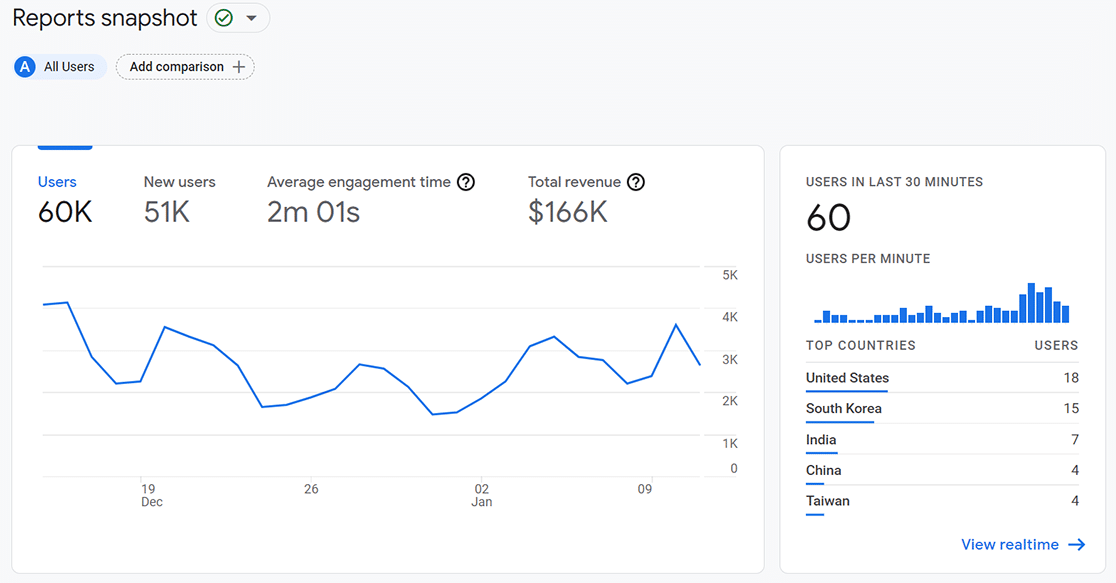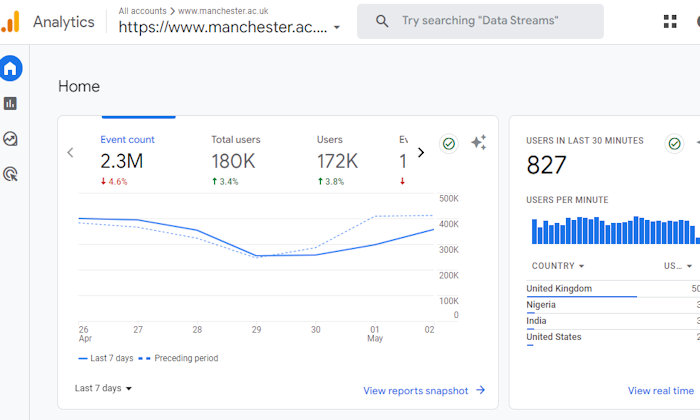Detailed Introduction: What Details Google Analytics Does Not Permit for Collection
Detailed Introduction: What Details Google Analytics Does Not Permit for Collection
Blog Article
Leveraging Google Analytics for In-Depth Insights Into User Habits and Involvement
In the electronic landscape where individual actions and involvement hold the crucial to online success, leveraging tools like Google Analytics has actually ended up being vital for services looking for to comprehend their audience's communications with their systems. This sophisticated analytics platform uses a wide range of information that can introduce complex details about just how users navigate web sites, involve with material, and eventually transform - what data does google analytics prohibit collecting. By using Google Analytics, organizations can discover valuable insights that surpass surface-level metrics, supplying a comprehensive understanding of customer actions and choices
Understanding Individual Habits Via Google Analytics
Utilizing Google Analytics supplies a comprehensive understanding of user actions on electronic systems. By evaluating information such as the variety of site visitors, their geographic areas, the web pages they check out, and the actions they take, businesses can acquire important understandings right into exactly how customers interact with their internet sites or applications. This info allows for informed decision-making, enabling companies to enhance their on-line visibility for boosted user experience and interaction.
One trick element that Google Analytics helps to discover is user website traffic patterns. By tracking metrics like the source of traffic, referral links, and popular key words, services can identify what drives customers to their platform. what data does google analytics prohibit collecting. This expertise help in customizing advertising techniques to target particular demographics or interests effectively
Additionally, Google Analytics uses in-depth reports on customer engagement, showcasing metrics like bounce rates, session periods, and conversion prices. Comprehending these metrics gives important responses on the efficiency of material, layout, and overall individual experience, encouraging organizations to make data-driven enhancements and drive far better results. Basically, Google Analytics functions as a powerful tool for deciphering individual actions and maximizing electronic systems for success.
Analyzing Web Site Traffic Patterns
Comprehending the circulation of website traffic on an internet site is crucial for enhancing its performance and boosting customer involvement. Assessing web site web traffic patterns gives useful understandings right into exactly how users engage with the site, what content they discover most appealing, and where they might be running into challenges. By leveraging tools like Google Analytics, web site proprietors can track metrics such as page views, distinct site visitors, bounce prices, and average session duration to gain a thorough understanding of customer actions.
Additionally, evaluating the actions circulation within the site can highlight preferred landing web pages, exit web pages, and the most common paths individuals take with the website. Identifying these patterns allows internet site proprietors to make informed choices regarding web content placement, navigation improvements, and general website layout to enhance customer experience and drive conversions.
Tracking User Involvement Metrics
To strengthen the understandings obtained from analyzing website traffic patterns, it is critical to focus on monitoring user involvement metrics. Customer involvement metrics supply beneficial details about just how visitors connect with a web site, showing the level of rate of interest and complete satisfaction with the web content. By tracking metrics such as bounce price, average session period, pages per session, and conversion prices, web site owners can understand the effectiveness of their content and customer experience.
Bounce price measures the percentage of visitors who browse far from useful content the website after seeing only one page, suggesting whether the content is engaging and appropriate. Ordinary session period exposes just how much time visitors spend on the website, mirroring their degree of interest. Pages per session metric shows the typical variety of web pages visitors see during a session, showing the depth of expedition. Conversion prices track the portion of site visitors that finish a desired activity, such as filling or making an acquisition out a type, reflecting the efficiency of the site in driving individual activities. By analyzing these individual engagement metrics, site proprietors can make enlightened decisions to optimize their web content and customer experience to improve involvement and accomplish their goals.
Identifying Conversion Opportunities
Recognizing potential conversion possibilities is a critical element of optimizing site efficiency and attaining preferred user actions. Via Google Analytics, companies can discover important understandings that can assist in identifying locations where individuals are leaving or not continuing to the wanted conversion activities. By evaluating metrics such as conversion prices, touchdown web page efficiency, and customer flow, companies can determine prospective bottlenecks in the conversion procedure.

Furthermore, using Google Analytics' behavior circulation function can provide an aesthetic representation of just how customers navigate through the site. This can assist in determining prominent pathways as well as any kind of barricades that might be preventing conversions. By leveraging these understandings, companies can enhance their site for improved customer experience and boosted conversion rates.
Enhancing Customer Experience With Data-Driven Insights
By leveraging data-driven understandings from Google Analytics, businesses can strategically maximize their web site to enhance user experience and drive greater conversion rates. Recognizing user behavior via information analysis permits firms to customize their internet view publisher site sites to fulfill the specific requirements and preferences of their target market. By recognizing vital metrics such as bounce rates, session duration, and preferred web pages, businesses can acquire beneficial understandings into how users engage with their website.
Google Analytics supplies in-depth details on customer demographics, gadgets made use of, and also the certain actions tackled the web site. This data allows organizations to make informed decisions on website design, content positioning, and total individual circulation. By leveraging these insights, companies can develop a more engaging and tailored individual experience, leading to boosted complete satisfaction and commitment.
Moreover, data-driven insights can help services recognize discomfort factors in the user journey and implement targeted enhancements to improve the conversion process. By continuously examining and keeping track of user actions, services can adapt and enhance their site visit this website to ensure a seamless and delightful experience for site visitors, ultimately driving greater conversion rates and taking full advantage of organization success.

Final Thought
Finally, Google Analytics offers important understandings into user behavior and engagement on internet sites. By evaluating web traffic patterns, tracking engagement metrics, and identifying conversion possibilities, companies can make data-driven choices to boost the individual experience. Leveraging these understandings can cause enhanced website performance and enhanced conversions.
By tracking metrics such as bounce rate, average session duration, pages per session, and conversion prices, website owners can comprehend the performance of their material and customer experience.
Conversion rates track the percentage of visitors that complete a desired action, such as loading or making an acquisition out a form, mirroring the effectiveness of the website in driving individual activities. By examining these user involvement metrics, website owners can make educated choices to enhance their web content and customer experience to improve engagement and accomplish their goals.
By leveraging these understandings, businesses can maximize their website for enhanced user experience and increased conversion rates.
By leveraging data-driven insights from Google Analytics, organizations can strategically maximize their website to boost user experience and drive greater conversion prices.
Report this page